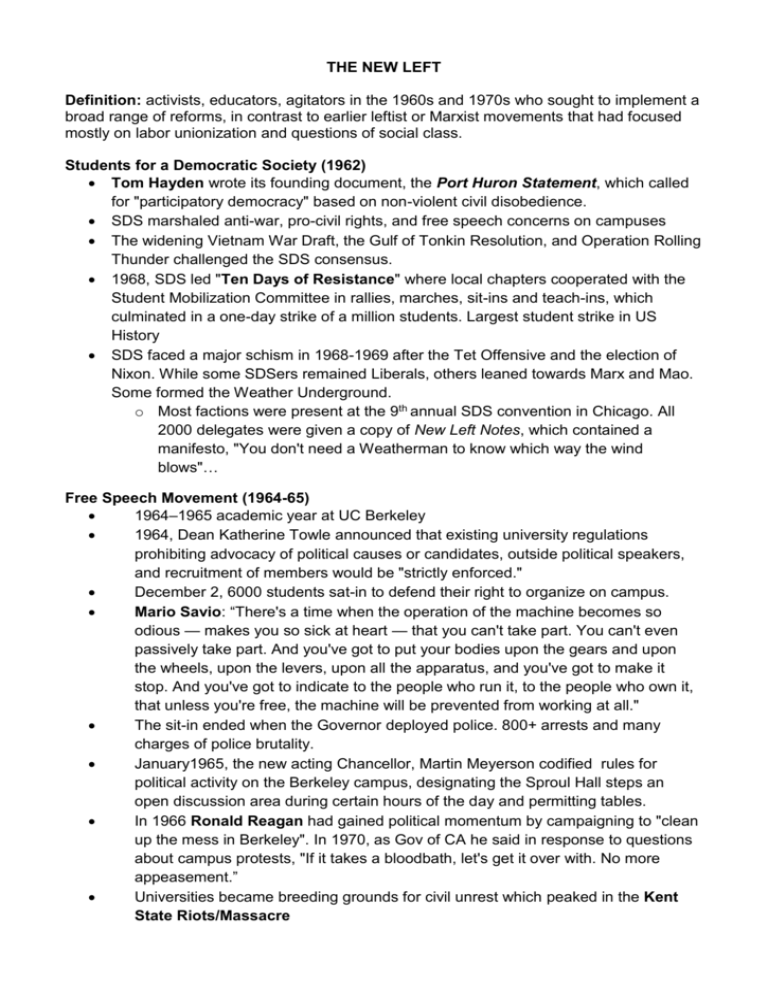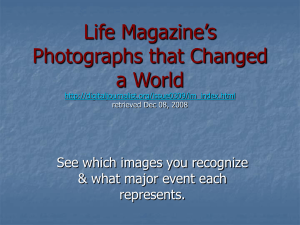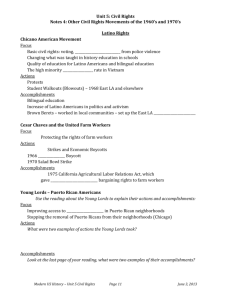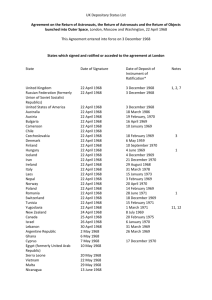Here is my lecture - Daniel Aaron Lazar
advertisement

THE NEW LEFT Definition: activists, educators, agitators in the 1960s and 1970s who sought to implement a broad range of reforms, in contrast to earlier leftist or Marxist movements that had focused mostly on labor unionization and questions of social class. Students for a Democratic Society (1962) Tom Hayden wrote its founding document, the Port Huron Statement, which called for "participatory democracy" based on non-violent civil disobedience. SDS marshaled anti-war, pro-civil rights, and free speech concerns on campuses The widening Vietnam War Draft, the Gulf of Tonkin Resolution, and Operation Rolling Thunder challenged the SDS consensus. 1968, SDS led "Ten Days of Resistance" where local chapters cooperated with the Student Mobilization Committee in rallies, marches, sit-ins and teach-ins, which culminated in a one-day strike of a million students. Largest student strike in US History SDS faced a major schism in 1968-1969 after the Tet Offensive and the election of Nixon. While some SDSers remained Liberals, others leaned towards Marx and Mao. Some formed the Weather Underground. o Most factions were present at the 9th annual SDS convention in Chicago. All 2000 delegates were given a copy of New Left Notes, which contained a manifesto, "You don't need a Weatherman to know which way the wind blows"… Free Speech Movement (1964-65) 1964–1965 academic year at UC Berkeley 1964, Dean Katherine Towle announced that existing university regulations prohibiting advocacy of political causes or candidates, outside political speakers, and recruitment of members would be "strictly enforced." December 2, 6000 students sat-in to defend their right to organize on campus. Mario Savio: “There's a time when the operation of the machine becomes so odious — makes you so sick at heart — that you can't take part. You can't even passively take part. And you've got to put your bodies upon the gears and upon the wheels, upon the levers, upon all the apparatus, and you've got to make it stop. And you've got to indicate to the people who run it, to the people who own it, that unless you're free, the machine will be prevented from working at all." The sit-in ended when the Governor deployed police. 800+ arrests and many charges of police brutality. January1965, the new acting Chancellor, Martin Meyerson codified rules for political activity on the Berkeley campus, designating the Sproul Hall steps an open discussion area during certain hours of the day and permitting tables. In 1966 Ronald Reagan had gained political momentum by campaigning to "clean up the mess in Berkeley". In 1970, as Gov of CA he said in response to questions about campus protests, "If it takes a bloodbath, let's get it over with. No more appeasement.” Universities became breeding grounds for civil unrest which peaked in the Kent State Riots/Massacre The Weather Underground (1969) To overthrow the American government. "The goal is the destruction of US imperialism and the achievement of a classless world: world communism." "We're against everything that's 'good and decent' in honky America. We will burn and loot and destroy. We are the incubation of your mother's nightmare." -John Jacobs Charismatic and articulate leaders whose revolutionary positions were characterized by anti-imperialist, feminist, and Black liberationist rhetoric. October 1969 - planted a bomb that blew up a statue commemorating police casualties incurred in the 1886 Haymarket Riot/Massacre October 1969 - The "Days of Rage" in Chicago timed to coincide with the trial of the Chicago Seven. WUO went to war with police for two days. o "Weatherman would shove the war down their dumb, fascist throats and show them, while we were at it, how much better we were than them, both tactically and strategically, as a people. In an all-out civil war over Vietnam and other fascist U.S. imperialism, we were going to bring the war home. " -John Jacobs May 1970 - issued a "Declaration of a State of War" against the US government in response to murder of Fred Hampton by Chicago police. June 1970 – 10-stick dynamite detonation in the NYC Police Headquarters (WUO always gave warning and evacuation time) May 1972 - Ho Chi Minh’s birthday, WUO detonated a bomb in the women’s bathroom in the Air Force wing of The Pentagon. “We felt that doing nothing in a period of repressive violence is itself a form of violence. That's really the part that I think is the hardest for people to understand. If you sit in your house, live your white life and go to your white job, and allow the country that you live in to murder people and to commit genocide, and you sit there and you don't do anything about it, that's violence.” – Naomi Jaffe WUO disbanded with end of Vietnam War o Bernadine Dohrn, once on FBIs Ten Most Wanted, is now a law prof at Northwestern o Bill Ayers is the Distinguished Professor of Education and Senior University Scholar at UIC o Mark Rudd is a retired math professor Youth International Party or YIPPIES (1968) Goal: decentralized, collective, anarchistic nation rooted in the borderless hippie counterculture and its communal ethos. Satirical and elaborate pranks made them (in)famous o The “Groucho Marxists” o Campaigned for Pigasus the Immortal for President in 1968 o Applied for a permit to levitate The Pentagon. o Abbie Hoffman arranged a tour of the NY Stock Exchange. Yippies threw hundreds of dollar bills from the balcony of the visitors' gallery to the floor below. NYSE shut down as wealthy men in suits trampled each other for dollar bills. o Jerry Rubin dressed like Santa Claus and a VC soldier at his HUAC interrogation o Threatened to spike the Chicago water supply with LSD o Detroit Yippies went to city hall and applied for a permit to blow up the General Motors building. After the permit was denied, Jumpin' Jack Flash said, “this destroys my last hope for legal channels.” 3 of the Chicago Seven (or 8 or 12) were Yippies The American Indian Movement (1968) Russell Means - first national director Thanksgiving 1970, seized the replica of the Mayflower. 1971 - occupied Mount Rushmore 1972 - marched the "Trail of Broken Treaties" to DC. Occupied the Bureau of Indian Affairs headquarters in DC for 6 days. Caused $700,000 in damages. 1972 - occupied Alcatraz Island for 19 months and reclaimed it for Natives 1973 – occupied Wounded Knee, SD in response to the 1890 massacre of 150+ Lakota Sioux men, women, and children by the U.S. Seventh Calvary o Occupied the Sacred Heart Church and the Gildersleeve Trading Post. 71 day FBI siege. Shooting from both sides. o 2 AIM members killed, many wounded Marlin Brando boycotted his Best Actor award for Godfather Academy Awards. Instead he sent Apache actress Sacheem Littlefeater to speak about US gov exploitation of Natives The Anti-War Movement Second Wave Feminism Whereas first-wave feminism focused mainly on overturning de jure obstacles to equality (i.e. voting rights, property rights), second-wave feminism addressed a wide range of de facto inequalities: sexual expression, sexual reproduction, family, patriarchy, federally funded daycare, workplace treatment and compensation, women in media, sexual violence and harassment… Postwar boom was a bust for many women. The Problem With No Name found a name in the 1960’s. 1963 – JFK formed Presidential Commission on the Status of Women which outlined plans for fair hiring practices, paid maternity leave, and affordable childcare. Passed Equal Pay Act of 1963 1963 - Betty Friedan published bestseller, The Feminine Mystique. Friedan founded NOW in 1966. 1964 - Title VII of the Civil Rights Act of 1964: barred employment discrimination on account of sex and race by private employers, employment agencies, and unions. Est the Equal Opportunity Employment Commission. 1965 - Griswold v. Connecticut: struck down the only remaining state law banning the use of contraceptives by married couples 1967 - Executive Order extending affirmative action rights to women 1967 – Valerie Solanas pens the SCUM Manifesto to “overthrow the government, eliminate the money system, institute complete automation and eliminate the male sex.” Argues that men have ruined the world and women must revolutionize it. Radical and polarizing. (She was also a paranoid schizophrenic who shot Andy Warhol) 1968 – Protests against Miss America Pageant 1969 – National Association for the Repeal of Abortion Laws (NARAL) founded 1972 – Title IX amendments to the Higher Education Act of 1965. Prohibits discrimination on the basis of sex in any federally funded education program 1972 – ERA reintroduced and passed by Congress. "Equality of rights under the law shall not be denied or abridged by the United States or by any State on account of sex." Died with only 35 states in 1982. 1973 – Roe v. Wade - privacy under the due process clause of the14th Amendment extended to a woman's decision to have an abortion. But that right must be balanced against the state's two legitimate interests in regulating abortions: protecting prenatal life and protecting women's health. 1974 - Equal Credit Opportunity Act 1975 – US Military Academies admit women 1975 – First Take Back the Night March Chicano Movement (El Movimiento) Operation Wetback was a frontal assault on Chicanos o Mexican gov begged US gov to return its labor force post WWII Bracero Program o Cold War hysteria. Open border concerns… o Forcibly removed immigrants from the US o 750 agents apprehended ~1,000 illegal immigrants a day o 1954 = 1,078,168 apprehensions o 1955 = 242,608 apprehensions (decline through 50’s) o Problems Deportation of Mexicans to unfamiliar places 25% were returned to Veracruz Often deported without opportunity to recover their property in the US or contact family Broad range of issues: farm workers' rights, improved education, voting and political rights, better relations with LAPD, and awareness of Chicano history. 1947 - Mendez, et al v. Westminster School District of Orange County: challenged racial segregation in Orange County, California schools. SC ruled that the segregation of Mexican and Mexican American students into separate "Mexican schools" was unconstitutional. 1949 – American G.I. Forum. AGIF received national exposure when pursued the cause of Felix Longoria, a Mexican-American serviceman who was denied funeral services in his hometown of Three Rivers, Texas after being killed during WWII. 1949 – “Pay Your Poll Tax” drives to register Latino voters. 1962 – Cesar Chavez and Dolores Huerta co-founded United Farm Workers (UFW). A five-year strike of grape pickers. RFK showed support. 1971 UFW Salad Bowl Strike: largest farm worker strike in US history 1970 - La Raza Unida Party consolidated various Chicano advocacy groups. Began in TX and moved west. Began with form workers’ rights and voter advocacy. Fought for education and peaceful relations with police in cities like LA Addressed negative ethnic stereotypes of Mexicans in mass media and the American consciousness. Latino artistic and cultural Renaissance emerged which validated Mexican American ethnicity and culture. Gay Liberation Movement The 1950’s restoration of “pre-war order” was unfriendly to LGBT community. The FBI kept lists of homosexuals. The US Post Office tracked recipients of materials deemed homophilic. 1953 - IKE signed Executive Order 10450, banning homosexuals from working for the federal government or any of its private contractors; cites homosexuals as security risks, along with alcoholics and neurotics. 1969 - Stonewall riots: LGBT patrons of the Stonewall Inn in NYC resisted a police raid 1970 - Stonewall riots commemorated by first annual Gay Pride Parade Gay Liberation Front (GLF) and the Gay Activists' Alliance (GAA) were formed. Their use of the word "gay" represented a new unapologetic defiance. GLF’s "A Gay Manifesto". "Out, loud and proud" Protested the classification of homosexuality as a mental illness by the APA in the DSM. In 1974 it was replaced with a category of "sexual orientation disturbance" then "ego-dystonic homosexuality", which was also deleted, although "gender identity disorder" remains. 1977 - Harvey Milk elected to SF Board of Supervisors. Assassinated in 1978 1979 - 75,000 March on Washington for Lesbian and Gay Rights in DC Emergence of “Moral Majority” in 1980’s 1981 - HIV/AIDS Epidemic (CDC initially refers to the disease as GRID, Gay Related Immune Deficiency Disorder) Environmentalism Struggles against: air and water pollution, solid waste disposal, dwindling energy resources, radiation, pesticide poisoning, noise pollution… 1946-1954 – 23 hydrogen bomb tests on Bikini Islands 1953 – The Silent World by Jacques Cousteau ushers interest in oceanic life 1955 – Air Pollution Control Act, first piece of legislation to address air pollution 1962 – Rachel Carson's Silent Spring condemns the overuse of pesticides. From1950-1962 amount of DDT found in human tissue tripled. 1963 – Clear Air Act passes, allocating $95 million for the study and cleanup of air and water pollution. Gives the federal government authority to reduce interstate air pollution 1965 – Water Quality Act 1966 – First Endangered Species Act 1968 – Paul R. Ehrlich's The Population Bomb 1968 – Pictures of Earth from space demonstrated Earth’s minuteness and fragility 1969 – catastrophic oil spill from offshore well in Santa Barbara Channel 1970 – federal programs consolidated into the Environmental Protection Agency (EPA) 1970 - Earth Day demonstrations 1973-74 - Arab Oil Embargo: suspension of oil shipments to the US. Gas prices skyrocket 400% from $3 to $12 a barrel. Encourages research into alternative energy 1977 - Carter sets goal of getting 20% of the nation’s energy from renewable energy resources by 2000. Establishes DOE 1979 – 3 Mile Island meltdown 1981 –Reagan appointed James Watt as Sec of Interior and Reagan cuts EPA budget to 44% of its 1978 level. In 1995, Watt was indicted on 25 counts of felony perjury and obstruction of justice. In 2008, Time named Watt as the sixth worst cabinet member in modern American history.









